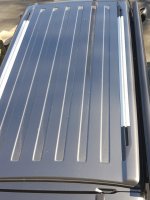- Home
- Forums
- VW California T5 T6 & T6.1 Specific Sections
- VW California T5,T6 & T6.1 Specific Sections
- Elevating Roof
You are using an out of date browser. It may not display this or other websites correctly.
You should upgrade or use an alternative browser.
You should upgrade or use an alternative browser.
TripleBee
I think it shall have to do with the height.
In the middle of the roof, there is a slight bend to both the front and the back.
If they put bumps instead of indents, the chance is that the bumps in the middle might get the van higher than 2 meters high.
They could however have flattened the channels out to the front and the back so the water can escape.
Now when you open the roof after a rain, and you are happy your tent is dry, it just gets wet on the backside
In the middle of the roof, there is a slight bend to both the front and the back.
If they put bumps instead of indents, the chance is that the bumps in the middle might get the van higher than 2 meters high.
They could however have flattened the channels out to the front and the back so the water can escape.
Now when you open the roof after a rain, and you are happy your tent is dry, it just gets wet on the backside

A
ainsy
Yeah maybe you're correct. I thought the same with the height but the raised part where the roof bars attach looks higher.I think it shall have to do with the height.
In the middle of the roof, there is a slight bend to both the front and the back.
If they put bumps instead of indents, the chance is that the bumps in the middle might get the van higher than 2 meters high.
They could however have flattened the channels out to the front and the back so the water can escape.
Now when you open the roof after a rain, and you are happy your tent is dry, it just gets wet on the backside
I thought maybe indented ones are stronger and needed with aluminium roof??
ArunAlec
Super Poster
VIP Member
Rigidity makes sense but would it be less rigid if they’d had the indents up the other way, so that water and crud didn’t puddle?Rigidity? Without the profile the roof would be even more flexible than it already is.
ArunAlec
Super Poster
VIP Member
Exactly, wonder if that is any less rigid?Like the OP says, on the van they are opposite.
View attachment 57331
westfalia
On the Cali its only a lid, in the upper part of theExactly, wonder if that is any less rigid?
bodywork its already been strengthened, so i would say
that the van style is stronger.
But they could both be the same.
Jabberwocky
Forever young (ish!)
Super Poster
Lifetime VIP Member
A good question. As has already been said I guess the overall height of the roof could be one reason why we have to put up with water and crud but I also think that the direction of the indents may be a question of the roof material being in compression or tension when flexing and what the designers are trying to achieve by this. I suspect that if the indents of the Cali roof were as the std van we would hear very many more complaints of bent roofs. Just a theory based on my memory of my Mechanics of Machines and Strength of Materials module at Uni.Rigidity makes sense but would it be less rigid if they’d had the indents up the other way, so that water and crud didn’t puddle?
Similar threads
- Replies
- 8
- Views
- 2K
- Home
- Forums
- VW California T5 T6 & T6.1 Specific Sections
- VW California T5,T6 & T6.1 Specific Sections
- Elevating Roof

About us
The VW California Club is the worlds largest resource for all owners and enthusiasts of VW California campervans.















